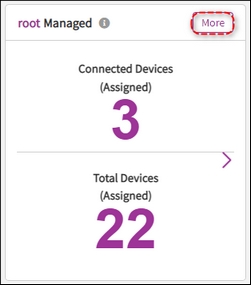Overview
Real-time Actions
Real-time actions provide one-click access to certain actions defined for specific device groups, providing a shortcut for efficient management. Examples for actions are batch screenshot and reboot.

For example, once you click “Reboot”, a confirmation dialog will pop up and will indicate which devices will actually be affected. Click on the device group button to get more details (individual devices names).


Schedule Tasks
In addition to real-time action, actions can be scheduled. An example for this is powering off or rebooting devices at a certain time of day. A calendar view is used to visualize upcoming tasks.

Event Log Statistic
There are three levels of event log on DeviceOn system, such as Warning, Error, and Information. Gives a summary and statistic result for current day. Click on the bar char to redirect Event Log tab to check detail log information.

For historical data, please click on “More” to compare the daily, weekly result.

In addition to analyzing the daily Event log results, we also support the comparison mode, you can click “Comparison Mode” to select the analysis of this week and last week.

Click on the bar chart for details that include which devices and severity.

System (Server Loading)
The system is focus on DeviceOn server loading and usage, including storage, CPU and Memory. The administrator could realize the real-time server uptime, downtime through the overview and based on the matrix to scale cloud performance.

Device Status

Device Managed Under [ACCOUNT NAME]: The total number of devices managed under the account and the number of connected or disconnected devices.
[ACCOUNT NAME] Managed: Device Managed by [ACCOUNT NAME], and the devices managed by the current account and low-privilege account, for example role of device admin.
Click on the “More” information on system managed to show the number of currently online devices as well as total number of managed devices.


System Managed Details: In addition to the usage status of the current system license number, it also includes the number of devices managed (assigned) per account.

Top 5 (High Risk)
DeviceOn leverages six common sensor types to identify potential high-risk devices. Those sensors are device disconnects, network traffic, disk usage, disk health, CPU usage and memory usage. This “top 5” overview allows to quickly identify potential issues and fix or replace the systems to avoid unexpected downtime.

Click “More” for details information.

Container
A summary of the containers managed under the account.

Clicking on the numbers reveals which containers are running on which devices.

Device Map
DeviceOn offers support for maps (latitude and longitude-based position) or floor plans to visualize the location of managed devices. User could define their location on the map and place the device to the area (floor plans).

Map List: Add the device or location on the Global Map, and then you could add an area (floor plans) or device into the location via “+” icon.
Map: Supports Open Street (Online, Offline), Google and Baidu Map.
Details: Display the location and device details. For on-premises and without public network environment, you could try to download an offline OpenStreet map and place into right place.
Last updated
Was this helpful?